Living the Dream by Living History
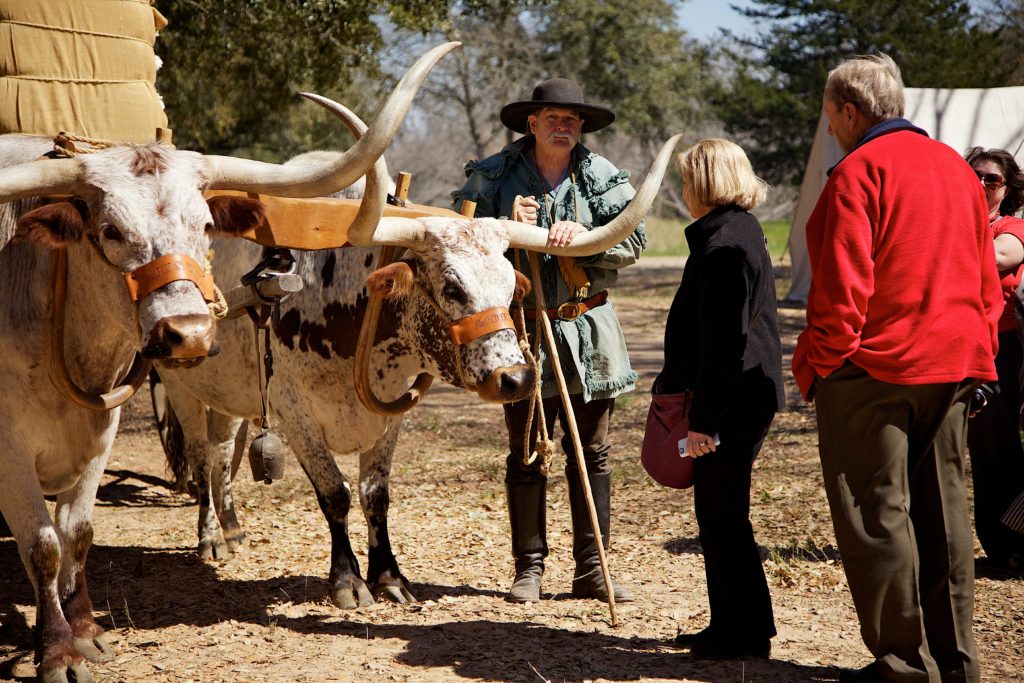
2025 Spring Antiques Show | March 20 – April 6
2025 Fall Antiques Show | October 4 – 18

For interpreter Laura Fisher, living history every day is living the dream.
“Not only do we preserve history by keeping traditions and techniques alive, but we get to pass it on,” said Fisher, who joined the staff at the Barrington Living History Farm at the Washington on the Brazos State Historic Site in 2017. “It’s everything I like to do rolled up into a dream job.”
Having a dream job makes her life dreamy as well.
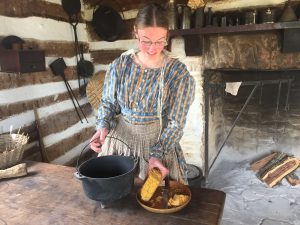
“I have the best of both worlds,” Fisher said. “I get to play in a garden all day, tend poultry and the farmstead like a pioneer woman and then go home, enjoy my air conditioner and microwave my dinner.”
Living with one foot in the 19th Century and the other in the 21st Century has given Fisher a unique perspective on a lot of things including fashion.
“I hate current fashion trends, especially pants that are so tight that you can’t get your hands in your pockets,” said Fisher, who is 26 years old. “I prefer the long loose comfortable dresses I wear at work and would rather climb a tree or jump a fence in a long dress than in modern pants.”
She continued, “For the record, a corset provides exceptional back support and is surprisingly comfortable to drive in.”
Although she is a child of the state park system, Fisher never considered becoming a park ranger.
“My father was the superintendent of the Fort Parker State Park, so I grew up there,” Fisher said. “There were no interpreters there. While I loved parks and Texas Parks and Wildlife, a career involving primarily facility and grounds maintenance held no interest for me.”
All that changed when her brother, Paul, got a summer internship at the Barrington Farm while he was in college. Fisher volunteered and fell in love with hands-on history. Her summer experience prompted her to major in history and minor in museum studies at Baylor University. During college she was a student worker at the Mayborn Museum, a museum on the Baylor campus that includes a 1890s Texas village. This job enriched her education with historic knowledge and experience, especially in historic gardening.
“I came to Barrington and learned historical gardening practices,” Fisher said. “Then I went back to Baylor and included them a research paper that I turned into a manual on historic gardening for the Mayborn’s Historic Village.”
Upon graduation, Fisher began working full-time at the Mayborn Museum, but continued volunteering at Barrington Farm. She maintained this split schedule until February 2017 when she came to Washington on the Brazos full-time. These days Fisher handles the household chores of a 1850s farm wife at Barrington Farm, the homestead of Anson Jones who was the last president of the Republic of Texas.
“At a living history site, people are encouraged to participate,” Fisher said. “It’s all about doing and touching, not about sitting and shushing.”
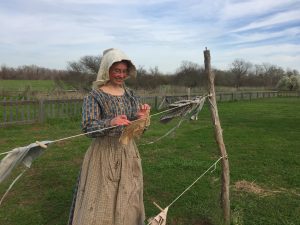
To that end, the Anson house has a working garden, an outdoor laundry, a mixed flock of poultry, a kitchen with a fireplace for cooking, and a bedroom doing double-duty as a school room. The farm is filled with more things to do.
“Our curators have done an incredible job of collecting authentic reproductions that people, especially children, can touch and use to get a true sense of the time, as well as originals that we don’t encourage people to touch, but it will be okay if they do,” Fisher said. “We want memorable experiences to be their souvenirs.” Enthusiastic interactivity complements her interpretative style.
“All interpreters have their own style,” Fisher said. “Mine is ‘excitement.’ There’s nothing I like better than a group of young kids who are curious about the world and excited to be at the farm. We feed off of each other—and learn a lot.”
One of her prized skills is recognizing teachable moments that other people dismiss as mere distractions. One her of her prized skills is recognizing teachable moments that other people dismiss as mere distraction. A case in point: two young boys in a school group were focusing on a wildflower and its seed head instead of looking at the hogs in the pen and listening to information about the role of pigs in pioneer life.
“Instead of fussing at them for not paying attention, I talked to them about the plant they were looking at,” Fisher said. “They now know we don’t pick wildflowers at state parks because each flower has hundreds of seeds that will never become flowers if it’s picked.”
Another valuable skill is turning a challenge into an opportunity. It takes creativity to protect the year’s potato crop from hornworms with a troop of Girl Scouts.
“Hornworms had attacked the potatoes,” Fisher said. “My group for the day was Girl Scouts, and a lot of girls get squeamish about touching worms, but I needed to take care of the infestation.”
Without saying a word, Fisher caught a hornworm and tossed it to a passing hen who fluttered her feathers and clucked her appreciation. Then Fisher asked, “Who else wants to feed the chickens?”
The girls flocked to the potato patch and plucked worms until the threat was gone and the hens were full.
“When children leave here and grow up, they might forget who Anson Jones was, but they will remember the place where they fed chickens and planted seeds,” Fisher said. “They will remember that history is ours to protect and share. They will know history is important—and fun.”
Another Interpretation
A Quick Chat with Jon Failor
RTR: What prompted you to dedicate your career to bringing history to life?
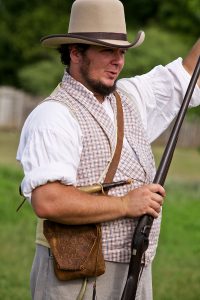
Ohio-born Jon Failor is the Historic Site Manager at the Barrington Living History Farm and Assistant Complex Superintendent at The Republic of Texas Complex, where he joined the staff as an agricultural interpreter in 2012. After a “life-changing encounter with history” as a child, teenage Failor searched out opportunities to volunteer at historic sites. In 2002, after six years as a volunteer, he became a museum and historic site professional on a mule-drawn canal boat in Northwest Ohio. A career move in 2004 allowed him to learn circa 1840s farming practices at Historic Brattonville in South Carolina, become the site manager, along with his wife Danielle, of the 1840s Island Farm on North Carolina’s Outer Banks—and eventually answer the call of Texas.
JF: It was 1990. I was 10-years-old. My family was vacationing on Michigan’s Upper Peninsula, and we went to Fort Michilimackinac, which was built by the French in the early 1700s. On this trip I encountered a Native American interpreter who took us into his darkened wigwam where the fire crackled and the smell of smoke filled the air. I still remember the way the bells on his bag jingled and the footfall of the soldiers marching around outside.
As he explained the customs of the Ojibwe and Chippewa people and their relations with British citizens, I became a time traveler. It was a real moment with real history that took me back 250 years. I knew right then that history was something that I wanted to be a part of my life.
Of course, I didn’t figure out that it was possible to make a living as an historical interpreter until much later in my life. I volunteered at historical sites as soon as I was old enough, but when I realized that somebody would pay me to share what I love with other people, it was an “Ah-ha! Let’s do this!” moment.
RTR: Do you ever have trouble going between the modern world and the mid-1800s?
JF: The hardest transition I ever had to make was the physical transformation that came from farming like they did in the mid-1800s. I was learning to plow using horses and oxen in South Carolina in the summer. Summer in South Carolina is like summer in this part of Texas—hot, humid and generally oppressive.
In the beginning I would work in the fields in the morning and then go into the air-conditioned staff room to eat lunch. Once I sat down in that cool room and ate a heavy lunch, it was a monumental struggle to go back outside. It didn’t take me long to figure out that I needed a farmer’s lunch—a piece of cheese or an apple with some water—eaten under a shade tree if I was going to survive the rigors of the work. Once you get acclimated, the breeze under a shade tree feels really good.
RTR: How do you get into “character?”
JF: I’m not a huge fan of first person interpretation because most people have trouble suspending their disbelief, and they have questions, such as: ‘What happened when the plantation sold?’
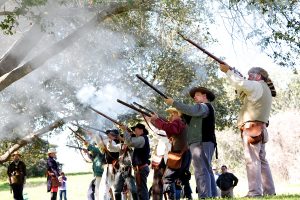
When interpreters are in first person, they have to maintain the character, so instead of being able to answer the question directly, they have to say something like, “Sold? Blasphemy. Can’t you see that we’re still working here?” Non-answers are frustrating for the visitors.
We use third person at Washingon on the Brazos except for very specific scripted presentations when guests know they are watching a performance. In third person the interpreters may be dressed in period clothing, but they are themselves.
Here’s the best way I’ve found to explain it. In first person it’s as if the interpreter is in a house and the visitors are watching through the window. In third person the interpreter is outside looking through the window with the visitors and having an unlimited conversation about what they’re seeing and why it matters.
RTR: What do you say to people who maintain that “history is boring?”
JF: History is not boring because people are not boring. At the root of all history is people who eat, sleep, breathe and experience the intense range of human emotions that we all do. Love, sorrow, joy and pain were part of their lives too.
Unfortunately too many times history classes emphasize dates. If history educators could focus on the people who experienced what we do, then the dates and events would come because their students would remember the people and their stories.
________________________________________________________________________
by Lorie A. Woodward
photos of Laura Fisher by Round Top Register
other photos courtesy of the Texas Parks and Wildlife Department
2025 Spring Antiques Show | March 20 – April 6
2025 Fall Antiques Show | October 4 – 18